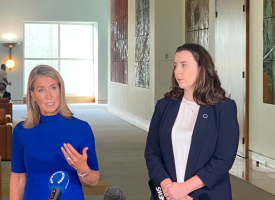Men's Health - 2018
1. Preamble
Australian men enjoy relatively good health outcomes, although they face different barriers to optimal health when compared to Australian women. Men are known to have greater vulnerability to various health disorders across their lifespan; they are more likely than women to experience serious health problems; men have a higher mortality rate, and they die in greater numbers than women from almost all non-sex-specific health problems[1]. The data on Australian men’s health also show higher rates of substance abuse, higher rates of suicide, and higher rates of mental health problems.
These barriers are caused, in the main, because Australian men are less likely to seek treatment from a general practitioner or other health professional, and are less likely to have in place the supports and social connections needed when they experience physical and mental health problems[2]. Compared to women, Australian men not only see their GP less often, but when they do access a health professional it is for shorter consultations, and typically when a condition or illness is advanced[3].
To be effective, policies on men’s health must recognise the different expectations, experiences, and situations facing Australian men. Health policies and programs must address the reasons why men are reluctant to engage with GPs, and the consequences of that reluctance, and invest in innovative models of care that overcome these barriers.
2. AMA Position:
- A National Men’s Health Strategy is needed to deliver a cohesive platform for the improvement of male health service access and men’s health outcomes.
- Health care services must be flexible and responsive to the complex and unique access needs of men. Increasing men’s engagement can be achieved through the provision of novel and flexible health care outreach programs.
- General practitioners play a significant role in improving the health of men and need to be supported to address specific men’s health needs. Men should be encouraged to develop meaningful, ongoing relationships with a regular GP.
- Improving health literacy among boys and adolescents will help to remove barriers to help-seeking in Australian men.
- Male suicide in Australia is at tragically high levels. Specific and targeted measures should be initiated to reduce the rates of suicide.
- Men and women should be given equal opportunity to realise their full potential for a healthy life.
- There is gender disparity in all analyses of illness, disease, and social determinants of health – and interventions must be properly funded and resourced to address this.
- Initiatives that address the health needs of one gender should not occur at the expense of the other gender.
- Social, cultural, and physiological determinants of health must always be considered from both a gender and lifespan perspective.
- Increased funding for early detection and treatment of illnesses that predominantly impact on men, particularly male-specific cancers such as testicular and prostate, is a priority in men’s health. Targeted mental health initiatives are needed to increase engagement between mental health services and Australian men.
- Migrant men are an expanding cohort of men in Australia. Health promotion initiatives must be cognisant of differing needs and expectations.
3. Accounting for differences in health outcomes
The reasons why men access health care less often than women are complex. What is clear is that the consequences of these differences are often manifested in individual and public health problems, such as the misuse of alcohol and drugs, employment and housing difficulties, family and domestic violence, and risk-taking behaviours.
A 2014 report on Men’s Health by the Victorian Government outlined a range of theories that may account for why Australian men have poorer health outcomes than women.[4] These include:
- greater expenditure is allocated to women’s and children’s health;
- men are more likely to be employed full-time than women, and may have less time for medical appointments;
- young men can behave as if they are invincible. This risk-taking behaviour is seen on roads, with young male drivers more likely to be killed or involved in road accidents, more likely to binge drink, take harmful substances, and engage in a reckless disregard for their physical safety[5];
- men are traditionally employed in high-risk jobs, especially in the trades, transport, construction, and mining industries;
- some men are more comfortable seeing a male health practitioner, particularly for genital problems;[6]
- Australian male culture perpetuates a distorted notion of masculinity; and
- men with mental health problems, such as depression, are much more likely than women to self-medicate and attempt to manage their symptoms through alcohol and other drugs.
Men and women also experience different health outcomes as a result of physiological differences, and socially constructed behavioural expectations. There are also genetic, physiological, and hormonal differences. There are both subtle and significant physiological differences between men and women, including hormonal, anatomical, metabolic, and chromosomal variations.
There are subtle and distinct differences in the emotional maturation of boys and girls.[7] These differences may be interpreted as disruptive or destructive behaviour, and can lead to boys becoming disenfranchised from mainstream education.
Understanding and accommodating the different rates of language acquisition between boys and girls, and differences in learning, including their social manifestations, must be recognised and considered as part of targeted health care strategies designed to improve access and improve the health of Australian men.
Risk-taking behaviour is another major factor, particularly in those under the age of 25. Australian men are more than twice as likely to die in a motor vehicle accident.[8] Males are significantly more likely than females to be both perpetrators and victims of violence, and, globally, it is estimated that almost twice as many men die as a result of injuries and violence than women.[9]
Family and Domestic Violence is detailed in the AMA Position Statement, Family and Domestic Violence - 2016, which explores the role of men as perpetrators, as well as the experience of male victims of FDV.
When it comes to gambling, Australian men gamble more frequently and are more likely to develop a gambling problem than Australian women.[10] Problem gamblers experience high levels of comorbid mental health disorders and substance abuse, and they or their families may experience stress-related physical and psychological ill health as a consequence of their gambling activities. The severe and pervasive health impacts of long-term problem gambling is addressed in the AMA Position Statement, The Health Effects of Gambling – 2013.
Australian men experience approximately 75 per cent of the burden of drug-related harm. Drug-related harms can have financial, social, and health impacts on the individual and their family and community. This is explored in further detail in the AMA Position Statement, Principles in Relation to Harm Caused by Substance Use and/or Compulsive Behaviour – 2017.
4. Adverse health outcomes in Australian men
Australian men have a life expectancy of approximately four years less than their female counterparts, and have a higher mortality rate from most leading causes of death.[11] They have a higher risk of developing chronic illnesses, such as ischaemic heart disease and type 2 diabetes, and account for almost 60 per cent of the fatal burden of disease. Australian men also have an increased risk of obesity. Just over 70 per cent of Australian men are overweight or obese, while just over 56 per cent of Australian women are overweight or obese.[12]
Obesity is a major risk factor for chronic conditions such as type 2 diabetes, heart disease, hypertension, stroke, musculoskeletal disorders, and impaired psychosocial functioning. The individual and public health impacts of obesity are further explored in the AMA Position Statement, Obesity – 2016.
Data on men’s health reveal that men born overseas generally experience better levels of health than Australian-born men.[13] Research from Deakin University notes that migrant men have lower mortality and hospitalisation rates than Australian-born men, and they also have lower rates of obesity and high blood pressure. These different health outcomes are attributed to several factors: migrants are not normally accepted if they have chronic conditions or ill-health; and some cultural, lifestyle, and dietary practices promote good health and behaviours. But it is also recognised that poor health literacy, language barriers, and cultural beliefs (especially about mental health) contribute to declining health outcomes for some overseas-born Australian men.
The gender disparities in life expectancy, and health outcomes more broadly between Australian men and women, are not unique, and are generally replicated in other comparable developed nations.[14]
Australian men are twice as likely as Australian women to exceed the lifetime risk guidelines for alcohol consumption, with approximately one in four men drinking at a rate that puts them at risk of alcohol-related disease. Males are also significantly more likely than females to consume more than four standard drinks in a single sitting, significantly increasing the risk of injury.[15]
5. Improving access to health services for men
Men typically have a functional view of their body and health, and consequently may ignore minor symptoms until they are severe enough to affect day-to-day tasks. This delay in help-seeking reduces the opportunity for early diagnosis and intervention, which can dramatically affect long-term prognosis for diseases, such as cancer and chronic illnesses. Some men feel reluctant to seek help when they are unsure about the severity of a problem, citing concerns such as embarrassment or not wanting to appear weak by unnecessarily seeking help.[16] Overcoming this perception is key to increasing male engagement with health services.
The underutilisation of health care services by men obviously has adverse health outcomes. Even when maternal health care visits are factored in, men are not seeking medical and mental health care or early interventions nearly as often as women. As already noted, there are practical and abstract barriers that affect the way in which Australian men interact with the health care system.
Initiatives to remove such barriers must be at the core of all men’s health interventions. Measures that could improve men’s access to health care include:
- flexible practice hours for GPs and medical clinics;
- recognising affordability/cost barriers for men in lower socio-economic situations;
- providing male doctors for those men who have difficulty confiding in female doctors;
- expanding the availability of male-focused community health services and interventions;
- expanding the maternal and child health infrastructure to include fathers – e.g. “parental and child health”;
- investing in outreach programs that seek to connect with men at workplaces or appropriate social settings, for example: football clubs[17], workplaces[18], pubs[19], and men’s sheds. These programs have proved to be effective because they help to overcome the practical barriers, as well as the social barriers, which impede access to health care services for Australian men;
- improving health literacy through greater education about the importance of accessing health care services;
- public awareness campaigns addressing unrealistic notions of masculinity, which can deter men from admitting vulnerabilities and seeking the appropriate help.[20]
6. Fatherhood
The role of fathers and the concept of fatherhood have changed considerably over recent decades, with many fathers now taking a more active role in the raising of their children. Both parents should be encouraged to actively participate in caring of their children. Supporting fathers to participate in the care of their children and teach healthy behaviours can be beneficial to the wellbeing of both the father and the child.
Approximately one in 10 new fathers experience postnatal depression in the first year of the baby’s life.[21] Access to mental health services for new parents should be improved, particularly the provision of culturally appropriate services for Indigenous and culturally and linguistically diverse (CALD) families, and for rural and remote families.
The percentage of single parent families in Australia is gradually increasing, and, similarly, the number of male single parents is on the rise.[22] Single fathers may be prone to feelings of isolation, as well as stigmatisation as a direct result of their family structure.
Incorporating both parents into “parental and child health services” allows a point of contact in a setting where the father is included in the responsibility or parenting, and can be screened for postnatal depression.
7. Mental Health
There is a significant comorbidity between mental and physical health outcomes. Approximately half of all Australian men will experience a mental illness over their lifetime, yet only a small portion will seek professional help. Men comprise over 75 per cent of all suicides in Australia, and intentional self-harm remains the leading cause of death for men under 54 years of age.[23]
Traditional notions of masculinity affect the way in which mental illnesses manifest in young men, and their ability to address emotional distress and seek help. Boys are often socialised to avoid showing vulnerability, which can increase stigma associated with seeking help for mental illness.[24] More research is needed to develop appropriate and accessible mental health services for young Australian men.
Mental health problems are particularly pronounced in young men, who access mental health services at a significantly lower rate than they experience mental ill-health. Compared to young women, young men experience higher rates of psychotic and alcohol and other drug disorders, but generally lower rates of mood disorders and anxiety.[25] There is a growing awareness of the way in which mental illnesses previously thought to primarily affect women, such as body image disorders, can manifest in men. Treatment services need to adapt to treat the increasing number of young men needing treatment for these disorders.
Mental health is further explored in the AMA Position Statement, Mental Health – 2018.
8. Cancer screening, treatment and funding
One in three Australian men will be diagnosed with cancer before their 75th birthday.[26] Despite being more likely to be diagnosed with bowel cancer, only 37 per cent of eligible Australian men participate in screening programs. For all cancers, males have a lower five-year survival rate than women.[27]
Factors that prevent men from engaging with screening initiatives stem from a combination of attitudinal barriers, and issues concerning the screening process. Screening processes for cancers such as prostate or bowel cancer are often seen as invasive and therefore unappealing. More needs to be done to raise awareness about the range of screening options available to patients, including less invasive tests.[28]
Prostate cancer was the third most common cause of cancer death in 2017,[29] yet receives significantly less funding in comparison to other cancers.[30]
9. Specific populations
Different populations of Australian men experience different health outcomes. These regional, socio-economic, racial, ethnic, and cultural differences can compound health disparities. Indigenous men, men from culturally and linguistically diverse (CALD) backgrounds, and men who live in regional and remote parts of Australia experience additional adverse health outcomes due to a combination of their vocation, lifestyle, physical and emotional isolation, and access to health services. These barriers contribute to a higher mortality rate than their counterparts, and lower levels of health literacy. Men in these areas require novel interventions to address these barriers to health.
Health outcomes for Indigenous men are further explored through the annual AMA Report Card on Indigenous Health, which explores health issues such as Rheumatic Heart Disease (RHD) and incarceration.
References
[1] Better Heath Channel. (2014). Men’s Health. https://www.betterhealth.vic.gov.au/health/conditionsandtreatments/mens-health
[2] See ‘The Quiet Crisis: Challenges for men’s Health in Australia’ By Associate Professor Lina Ricciardelli FAPS, Professor David Mellor MAPS and Professor Marita McCabe FAPS, Centre for Mental Health and Wellbeing Research, Deakin University. www.psychology.org.au/inpsych/2012/august/ricciardelli.
[3] Better Heath Channel. (2014). Men’s Health. https://www.betterhealth.vic.gov.au/health/conditionsandtreatments/mens-health
[4] Better Heath Channel. (2014). Men’s Health. https://www.betterhealth.vic.gov.au/health/conditionsandtreatments/mens-health
[5] Reniers RLEP, Murphy L, Lin A, Bartolomé SP, Wood SJ (2016) Risk Perception and Risk-Taking Behaviour during Adolescence: The Influence of Personality and Gender. PLoS ONE 11(4): e0153842. https://doi.org/10.1371/journal.pone.0153842
[6] Stanford L, Bonney A, Ivers R, Mullan J, Rich W, Dijkmans-Hadley B (2017) Patients’ attitudes towards chaperone use for intimate physical examinations in general practice. Available at: https://www.racgp.org.au/afp/2017/november/patients-attitudes-towards-chaperone-use/
[7] Chaplin TM. Gender and Emotion Expression: A Developmental Contextual Perspective. Emotion review : journal of the International Society for Research on Emotion. 2015;7(1):14-21. doi:10.1177/1754073914544408.
[8] Australian Government Department of Infrastructure and Regional Development (2016) Road Trauma Australia 2015 Statistical Summary. Available at: https://bitre.gov.au/publications/ongoing/files/Road_trauma_Australia_2015.pdf
[9] World Health Organization. 2014. Injuries and violence: the facts 2014. Available at: http://www.who.int/violence_injury_prevention/media/news/2015/Injury_violence_facts_2014/en/
[10] Victorian Responsible Gambling Foundation. (2014) Gender gap highlighted in new gambling study. Available at: https://www.responsiblegambling.vic.gov.au/about-us/newsroom/latest-news/gender-gap-highlighted-in-new-gambling-study
[11] Australian Institute of Health and Welfare. (2018). Life Expectancy and Deaths. Availabe at: https://www.aihw.gov.au/reports-statistics/health-conditions-disability-deaths/life-expectancy-deaths/overview
[12] Australian Institute of Health and Welfare. (2018). Overweight and obesity. Available at: http://www.aihw.gov.au/who-is-overweight/#adults
[13] The Quiet Crisis: Challenges for men’s Health in Australia By Associate Professor Lina Ricciardelli FAPS, Professor David Mellor MAPS and Professor Marita McCabe FAPS, Centre for Mental Health and Wellbeing Research, Deakin University http://www.psychology.org.au/inpsych/2012/august/ricciardelli/
[14] Baker P, Dworkin S, Tong S, Banks I, Shand T, Yamey G. (2014) The men’s health gap: men must be included in the global health equity agenda. Available at: http://www.who.int/bulletin/volumes/92/8/13-132795/en/
[15] Australian Bureau of Statistics. (2015) National Health Survey: First Results, 2014-2015. Available at: http://www.abs.gov.au/ausstats/abs@.nsf/Lookup/by%20Subject/4364.0.55.001~2014-15~Main%20Features~Alcohol%20consumption~25
[16] Yousaf O, Grunfield E & Hunter M. (2013). A systematic review of the factors associated with delays in medical and psychological help-seeking among men. Available at: https://doi.org/10.1080/17437199.2013.840954
[17] See: Maribyrnong City Council. Sons of the West. https://www.maribyrnong.vic.gov.au/files/Attachments/NOV14_CSSC_Sons_of_the_West_Program.pdf
[18]Australian Government Department of Health and Aging. (2010) National Male Health Policy Supporting Document: Access to Health Services. Available at: http://www.health.gov.au/internet/main/publishing.nsf/content/7935AC78159969D4CA257BF0001C6B07/$File/Access%20to%20health%20services.pdf
[19]Improving men’s health and wellbeing Resource: data and evidence (https://www2.health.vic.gov.au/.../%7BB131BD68-EA4A-4D62-9173-64C2A13B440)
[20] Orygen. (2017) Keeping it real: Reimagining mental health care for all young men. Available at: https://www.orygen.org.au/Policy-Advocacy/Policy-Reports/Keeping-it-real/Keeping-it-real-Policy-Paper.aspx
[21] Perinatal Anxiety and Depression Australia. (2017) After Birth: Having a new baby can be both an exciting and challenging time for new mums and dads. Available at: https://www.panda.org.au/info-support/after-birth?gclid=EAIaIQobChMIhcqB24Pb2AIVCyUrCh3qRgtKEAAYASAAEgIIifD_BwE
[22]Australian Bureau of Statistics. (2013) Labour Force, Australia: Labour Force Status and Other Characteristics of Families, Jun 2012. Available at: http://www.abs.gov.au/ausstats/abs@.nsf/Products/6224.0.55.001~Jun%202012~Chapter~one%20Parent%20Families
[23] Australian Bureau of Statistics. (2016). Causes of Death Australia 2014, preliminary data., Cat. no. (3303.0). Canberra: ABS
[24] Orygen. (2017) Keeping it real: Reimagining mental health care for all young men. Available at: https://www.orygen.org.au/Policy-Advocacy/Policy-Reports/Keeping-it-real/Keeping-it-real-Policy-Paper.aspx
[25] Orygen. (2017) Keeping it real: Reimagining mental health care for all young men. Available at: https://www.orygen.org.au/Policy-Advocacy/Policy-Reports/Keeping-it-real/Keeping-it-real-Policy-Paper.aspx
[26] Australian Cancer Research Foundation. (2018). Cancer Statistics. Available at: https://acrf.com.au/on-cancer/cancer-statistics-australia/
[27] Australian Institute of Health and Welfare. (2017). Cancer in Australia 2017. Available at: https://www.aihw.gov.au/getmedia/3da1f3c2-30f0-4475-8aed-1f19f8e16d48/20066-cancer-2017.pdf.aspx?inline=true
[28] Duffy SW, Myles JP, Maroni R, Mohammad A. Rapid review of evaluation of interventions to improve participation in cancer screening services. Journal of Medical Screening. 2017;24(3):127-145. doi:10.1177/0969141316664757.
[29] Australian Institute of Health and Welfare. (2017). Cancer compendium: information and trends by cancer type. Available at: https://www.aihw.gov.au/reports/cancer/cancer-compendium-information-and-trends-by-cancer-type/report-contents/prostate-cancer-in-australia
[30] SBS News. (2015). Charities hope for increased cancer funds. Available at: https://www.sbs.com.au/news/charities-hope-for-increased-cancer-funds



